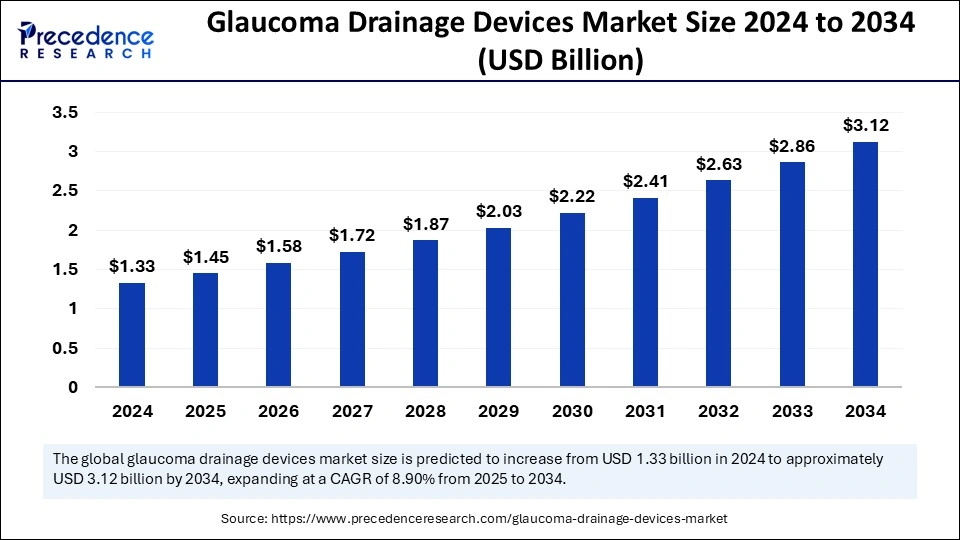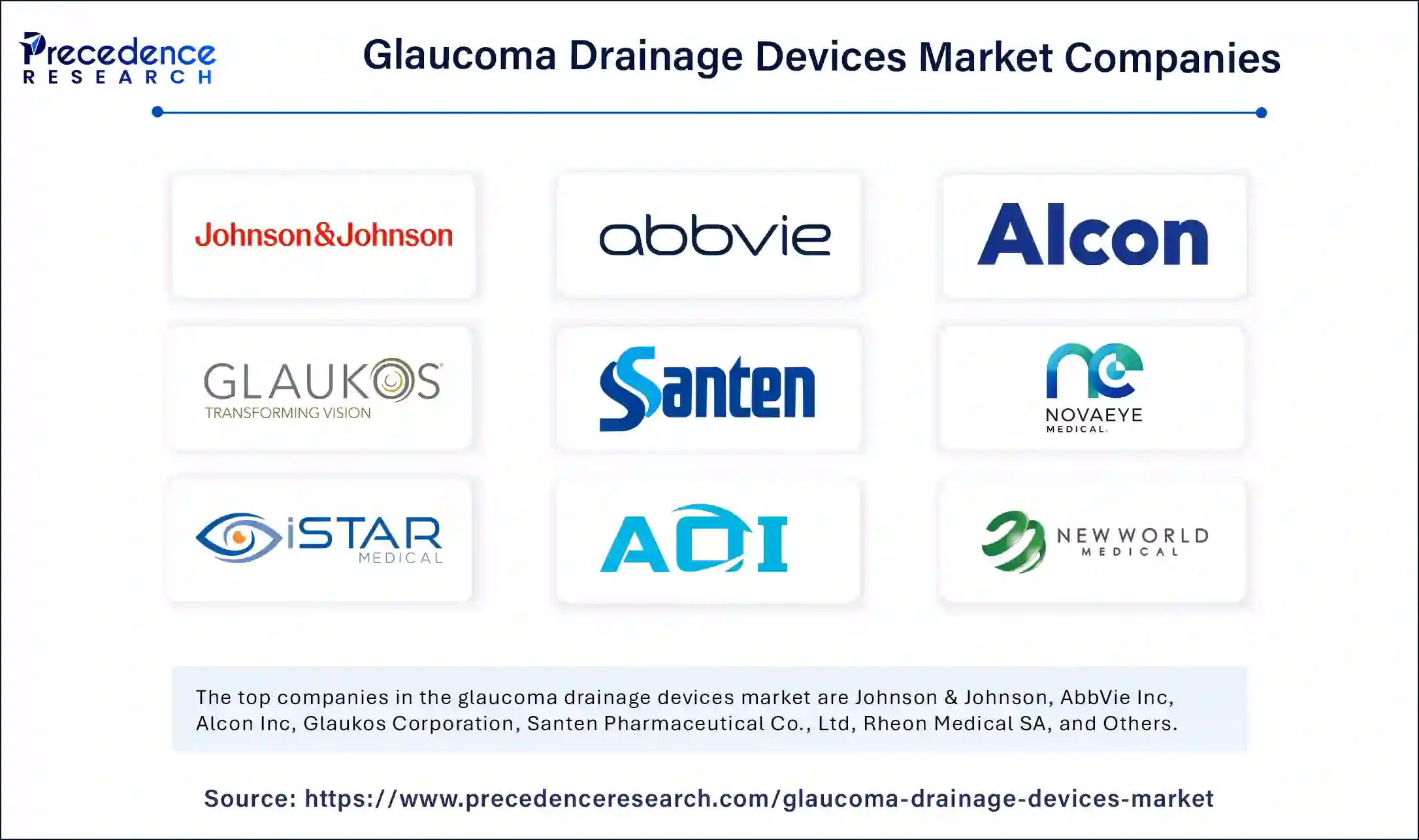March 2024
The global glaucoma drainage devices market size is calculated at USD 1.45 billion in 2025 and is forecasted to reach around USD 3.12 billion by 2034, accelerating at a CAGR of 8.90% from 2025 to 2034. The market sizing and forecasts are revenue-based (USD Million/Billion), with 2024 as the base year.
The global glaucoma drainage devices market size was estimated at USD 1.33 billion in 2024 and is predicted to increase from USD 1.45 billion in 2025 to approximately USD 3.12 billion by 2034, expanding at a CAGR of 8.90% from 2025 to 2034. The glaucoma drainage devices market is growing rapidly due to rising government initiatives to spread awareness about early detection to prevent blindness, advancements in drainage devices, and the growing prevalence of glaucoma.

The integration of artificial intelligence (AI) technologies in glaucoma care significantly improves patient outcomes. AI has the ability to transform glaucoma care. It analyses patient data, such as imaging scans and medical history, assisting ophthalmologists in selecting suitable glaucoma drainage devices for individual patients. Advances in robotic surgery and computer-driven guidance demonstrate AI’s potential to enhance medical outcomes and surgical training. AI-driven platforms are also able to continuously monitor patient health post-glaucoma surgery, improving patient outcomes. AI also enables accurate and early diagnosis of glaucoma. Integrating AI technologies in glaucoma care helps personalize treatment, enhance decision-making, improve treatment efficacy, and reduce the risk of disease progression.
A glaucoma drainage is a small device implanted in the eyes to treat glaucoma. Glaucoma drainage devices are used in more complex glaucomas where there is a high risk of failure of traditional glaucoma surgery. They are designed to divert excess fluid, known as aqueous humor, from the anterior chamber to an external reservoir. After implantation, a fibrous capsule forms around the device, typically within 4-6 weeks, which regulates the flow of aqueous humor. These devices help control intraocular pressure (IOP) in eyes with insufficient conjunctiva because of scarring from previous surgical injuries and previously failed trabeculectomy. The rising awareness among people about eye health is expected to boost the growth of the glaucoma drainage devices market during the forecast period.
| Report Coverage | Details |
| Market Size by 2034 | USD 3.12 Billion |
| Market Size in 2025 | USD 1.45 Billion |
| Market Size in 2024 | USD 1.33 Billion |
| Market Growth Rate from 2025 to 2034 | CAGR of 8.90% |
| Dominating Region | North America |
| Fastest Growing Region | Asia Pacific |
| Base Year | 2024 |
| Forecast Period | 2025 to 2034 |
| Segments Covered | Product Type, End-user, and Regions |
| Regions Covered | North America, Europe, Asia-Pacific, Latin America, and Middle East & Africa |
Increasing Prevalence of Glaucoma
With the increasing prevalence of glaucoma worldwide, the adoption of glaucoma drainage devices is increasing, which is a key factor driving the growth of the market. These devices are a secondary treatment option for medically uncontrolled glaucoma. GDDs are designed for patients with secondary glaucoma or those at huge risk of trabeculectomy failure. These devices have gained widespread acceptance due to their proven effectiveness across various glaucoma types. They are applied in complicated glaucomas, like neovascular glaucoma, uveitic glaucoma, and developmental and pediatric glaucoma.
As glaucoma remains the leading cause of irreversible blindness worldwide, the preference for GDDs over traditional surgical interventions is rising. The rising volume of glaucoma surgical procedures underscores the need for advancements in surgical processes and drainage device designs. Moreover, the growing aging population drives the growth of the glaucoma drainage devices market. Vision loss because of glaucoma adversely affects the independence of older adults, boosting the need for glaucoma drainage devices.
Post-Surgical Complications
The growth of the market hampers due to post-surgical challenges. Similar to traditional surgery, glaucoma drainage device (GDD) surgery may increase the risk of endophthalmitis, hypotony, extrusion, plate migration, and mucous membrane erosion. A major restraint in GDD surgery is the high risk of postoperative hypotony. This limits the adoption of GDDs. Moreover, the availability of other treatment options, such as laser therapy, limits the growth of the glaucoma drainage devices market.
Innovation in Glaucoma Drainage Devices
Advancements in glaucoma drainage devices (GDDs) create immense growth opportunities in the market. Recent innovations, including modifications to reductions in internal tube diameter, endplate design, and advanced biocompatible materials, have enhanced device efficacy while reducing challenges. The introduction of novel devices like the Ahmed ClearPath and Paul glaucoma implant has escalated the range of available treatment options, providing outcomes comparable to traditional devices. As these next-generation GDDs gain traction among glaucoma specialists, the market is expected to grow rapidly in the coming years.
The minimally invasive glaucoma surgery (MIGS) devices segment dominated the market in 2024. This is mainly due to the heightened awareness among people about the long-term benefits of minimally invasive procedures. MIGS devices manage intraocular pressure in the initial stages of glaucoma, decreasing patients' long-term reliance on other treatments and medications. These devices have emerged as a reliable surgical option for complex glaucoma. MIGS usually involves the application of a small device that is injected or placed through a clear corneal incision approached from inside the eye. This approach leads to minimal tissue interruption and quicker recovery as compared to traditional trabeculectomy or glaucoma drainage device implantation.
The conventional glaucoma drainage devices segment is expected to grow at the fastest rate during the forecast period. Conventional glaucoma drainage devices make an alternate pathway for aqueous outflow. They channel the aqueous humor from the anterior chamber toward the sub-conjunctival space through a tube of the device. Conventional glaucoma drainage devices are suitable for cases with refractory glaucoma or those unlikely to respond effectively to traditional filtration surgery. The lower cost of conventional glaucoma drainage devices than MISG devices is expected to support segmental growth.
The hospitals segment dominated the glaucoma drainage devices market in 2024. This is mainly due to the increased patient pool in hospitals. The availability of skilled professionals and advanced surgical devices are major factors encouraging patients to perform surgery in hospitals. Glaucoma drainage devices used in hospitals are significant options in the management of complicated glaucomas that carry a greater risk of failure from conventional filtering treatment. Glaucoma drainage devices effectively control intractable glaucoma even after a very complex stage. The treatment success rates are dependent on the extent of follow-up, types of glaucoma, and success criteria.
The specialty clinics segment is likely to grow at a notable during the projection period. The segment growth can be attributed to the rising preference for outpatient care. Ophthalmic clinics offer personalized and convenient treatment options, attracting more patients. Clinics often offer more cost-effective treatment than hospitals. The rising awareness among people about outpatient surgeries, such as reduced hospital stays and specialized care, is expected to support segmental growth.
North America’s Stronghold on the Market
North America dominated the glaucoma drainage devices market with the largest share in 2024. This is mainly due to the rise in healthcare expenditure and the presence of a well-established healthcare sector. The region boasts some of the world's leading eye care institutions, offering a wide range of specialized surgeries. The availability of skilled healthcare professionals, advanced technological, and novel therapies further bolstered the market growth in the region.
The U.S. is a major contributor to the North American glaucoma drainage devices market. The high prevalence of glaucoma and the growing aging population are major factors that support market growth in the U.S. According to the CDC, an estimated 4.2 million Americans of all ages were living with glaucoma in 2022, including 1.5 million people with vision-affecting glaucoma. MIGS has gained immense popularity because of its ability to link the gap between medication therapy and non-invasive surgical options, offering a safer and more effective alternative for many glaucoma patients in the U.S. In addition, the country is at the forefront of ophthalmic innovation.
Asia Pacific: The Fastest-Growing Region
Asia Pacific is expected to be the fastest-growing region in the market. Rising innovations in healthcare technology and increasing popularity of minimally invasive surgery are expected to drive the market growth in the region. The rising healthcare spending also fuels market growth. Moreover, rising government focus on improving existing healthcare facilities and improving access to healthcare, especially in rural or underserved areas, influences the market.
Countries like India and China are expected to have a stronghold on the Asia Pacific glaucoma drainage devices market. This is mainly due to the rising prevalence of glaucoma. According to the National Institutes of Health (NIH), glaucoma is estimated to affect more than 27.8 million people by 2040 in Asia Pacific, with India and China having a maximum burden. The rising government initiatives to spread awareness about eye health and promote eye care further boost the growth of the market. For instance, the Indian government’s National Program for Control of Blindness and Visual Impairment (NPCBVI) aims to address the nation's rising blindness and visual impairment rates by supporting school eye screening programs and promoting cataract surgeries.
Europe: A Notably Growing Area
Europe is considered to be a significantly growing area due to the increasing spending on eye care to improve societal health outcomes. The region boasts a robust healthcare system with advanced ophthalmology facilities. There is a high demand for novel treatment options for glaucoma. The growing aging population and the rising incidence of age-linked eye diseases further support the glaucoma drainage devices market in the region.

By Product Type
By End-User
By Region
For inquiries regarding discounts, bulk purchases, or customization requests, please contact us at sales@precedenceresearch.com
No cookie-cutter, only authentic analysis – take the 1st step to become a Precedence Research client
March 2024
October 2024
September 2024
February 2025